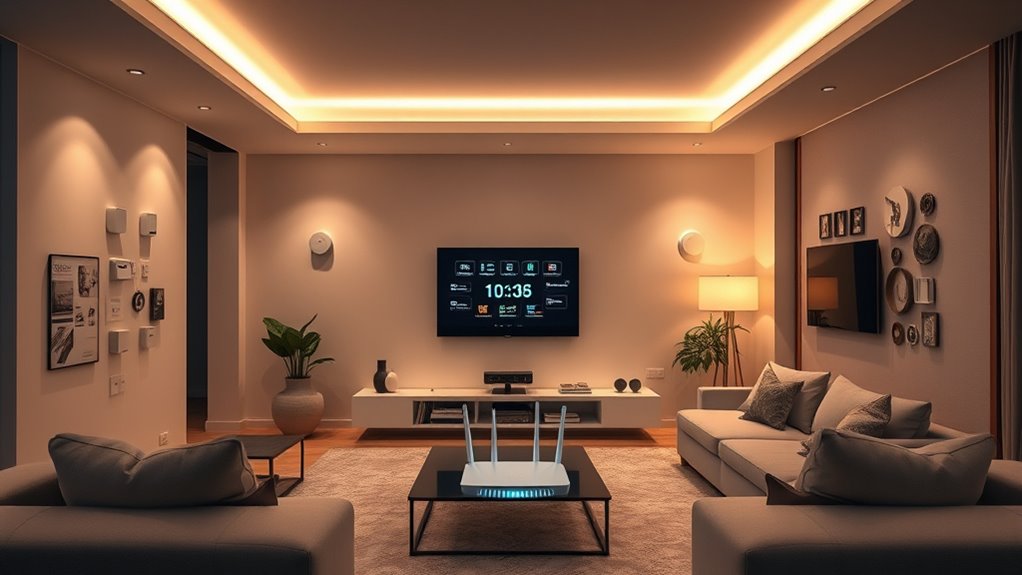To design a smart home network, select appropriate protocols like Wi-Fi for high bandwidth and Zigbee or Z-Wave for low-power devices. Implement layered security measures, including strong passwords, encryption, network segmentation, and regular updates, to protect your devices. Optimize energy use by monitoring device activity and choosing efficient protocols. Maintaining these practices guarantees a secure, reliable, and energy-efficient system. If you continue exploring, you’ll discover how to tailor your network for maximum safety and performance.
Key Takeaways
- Select appropriate wireless protocols (Wi-Fi, Zigbee, Z-Wave) based on device data rate and power requirements.
- Segment the network with dedicated guest or IoT networks to enhance security and reduce interference.
- Enable strong encryption (WPA3) and change default passwords to protect against unauthorized access.
- Disable unnecessary features like remote access and UPnP to minimize security vulnerabilities.
- Regularly update device firmware and monitor network activity to maintain security and optimize performance.

Ever wondered how to create a reliable and secure network for your smart home devices? Building a solid foundation starts with understanding wireless protocols. These protocols are the language your devices use to communicate, and choosing the right ones is vital. Common options like Wi-Fi, Zigbee, Z-Wave, and Bluetooth each have their strengths and limitations. Wi-Fi offers high data rates suitable for streaming and high-bandwidth applications but can be more vulnerable if not properly secured. Zigbee and Z-Wave are designed specifically for low-power, low-data devices, making them ideal for sensors and lighting controls, and they often operate on different frequencies to reduce interference. Bluetooth is excellent for short-range connections but less common for whole-home networks. Selecting the appropriate wireless protocols depends on your specific devices and their communication needs.
While these protocols enable seamless device interaction, they also introduce security challenges. Wireless networks are inherently more exposed than wired connections, making them attractive targets for hackers. If your network isn’t properly secured, intruders could gain access to your devices, compromising your privacy or even controlling essential systems like locks or security cameras. The key to overcoming these security challenges is to implement robust measures. Start by changing default passwords on your devices and Wi-Fi router; many vulnerabilities stem from manufacturers’ default settings. Use strong, unique passwords that are difficult to guess. Enable WPA3 encryption on your Wi-Fi network—if available—since it provides a higher level of security compared to older standards like WPA2. Regularly update your device firmware and router software to patch security vulnerabilities that could be exploited. Additionally, understanding the power consumption of your devices helps manage energy use and operational costs effectively.
Segmenting your network can also bolster security. Create a separate guest network for visitors or less secure devices, isolating your main network from potential threats. This way, even if a less secure device is compromised, your core smart home systems remain protected. Additionally, disable unnecessary features such as remote access or universal plug and play (UPnP), which can be exploited by attackers. Consider implementing a firewall and network monitoring tools to detect unusual activity. These steps help you identify and block threats before they can do serious damage.
Designing a secure smart home network isn’t just about choosing the right wireless protocols; it’s about layering security measures to address the inherent vulnerabilities of wireless communication. By understanding the strengths and weaknesses of different protocols and proactively safeguarding your network, you create a safer environment for your smart devices—and for your privacy. It’s a continuous process, but with deliberate planning and regular maintenance, you can enjoy the convenience of smart home technology without compromising security.
Frequently Asked Questions
How Can I Improve Wi-Fi Coverage in Large Homes?
You can improve Wi-Fi coverage in large homes by setting up a mesh network, which creates a seamless connection across multiple nodes, ensuring consistent coverage. Additionally, use range extenders strategically to boost signals in dead zones. By combining these solutions, you’ll enjoy faster, more reliable internet throughout your home, minimizing interruptions and enhancing your smart home experience.
What Security Protocols Are Best for Smart Home Networks?
You should use WPA3 encryption standards, as they offer the latest security for smart home networks. Combine this with strong authentication methods like two-factor authentication or unique passwords for each device. Regularly update your firmware to patch security vulnerabilities and disable default passwords. By applying these protocols, you’ll markedly enhance your network security, protecting your smart devices from unauthorized access and potential cyber threats.
How Do I Prioritize Bandwidth for Critical Devices?
Your network is a bustling city, and bandwidth management is the traffic cop. To prioritize critical devices, set up device prioritization through Quality of Service (QoS) settings on your router. Assign higher bandwidth to essential gadgets like security cameras or smart thermostats. This way, your crucial devices get the bandwidth they need first, ensuring smooth operation even during peak usage. Stay in control and keep your smart home running flawlessly.
Can I Set up a Guest Network Securely?
Yes, you can set up a guest network securely. Start by creating a separate guest network on your router, ensuring it has a strong, unique password. Enable WPA3 encryption if available, and disable access to your main network and devices. Regularly update your router’s firmware to patch security vulnerabilities. This secure setup keeps your main devices safe while allowing visitors to connect without risking your primary network’s security.
What Are the Future Trends in Smart Home Networking?
You’ll see smart home networks evolve rapidly, with over 60% of homes expected to adopt AI integration by 2025. Future trends include mesh networking, which enhances coverage and reliability, making your devices smarter and more responsive. AI will enable your system to predict needs and optimize performance automatically. By embracing these advancements, you’ll enjoy seamless connectivity and smarter automation, transforming your home into a truly intelligent space.
Conclusion
By designing a dedicated, secure network, you guarantee your smart home devices work seamlessly and stay protected. For example, imagine setting up a separate Wi-Fi network just for your smart devices—this isolates potential threats and keeps your personal data safe. Taking these steps means you can enjoy smarter living without worries, knowing your devices are reliable and secure. Prioritize a well-planned network, and your smart home will run smoothly and securely.





